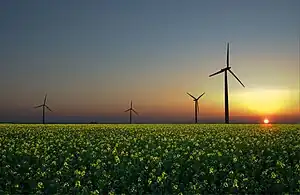Portal:Renewable energy/Selected article/12
Renewable energy commercialization involves the deployment of three generations of renewable energy technologies dating back more than 100 years. First-generation technologies, which are already mature and economically competitive, include biomass, hydroelectricity, geothermal power and heat. Second-generation technologies are market-ready and are being deployed at the present time; they include solar heating, photovoltaics, wind power, solar thermal power stations, and modern forms of bioenergy. Third-generation technologies require continued R&D efforts in order to make large contributions on a global scale and include advanced biomass gasification, hot-dry-rock geothermal power, and ocean energy. As of 2012, renewable energy accounts for about half of new nameplate electrical capacity installed and costs are continuing to fall.

Public policy and political leadership helps to "level the playing field" and drive the wider acceptance of renewable energy technologies. Countries such as Germany, Denmark, and Spain have led the way in implementing innovative policies which has driven most of the growth over the past decade. As of 2014, Germany has a commitment to the "Energiewende" transition to a sustainable energy economy, and Denmark has a commitment to 100% renewable energy by 2050. There are now 144 countries with renewable energy policy targets. (Full article...)